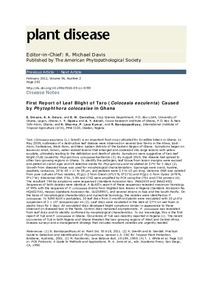| dc.contributor.author | Omane, E. |
| dc.contributor.author | Oduro, K. A. |
| dc.contributor.author | Cornelius, E. |
| dc.contributor.author | Opoku, I. |
| dc.contributor.author | Akrofi, A. |
| dc.contributor.author | Sharma, K. |
| dc.contributor.author | Kumar, P.L. |
| dc.contributor.author | Bandyopadhyay, Ranajit |
| dc.date.accessioned | 2019-12-04T11:04:15Z |
| dc.date.available | 2019-12-04T11:04:15Z |
| dc.date.issued | 2012 |
| dc.identifier.citation | Omane, E., Oduro, K.A., Cornelius, E.W., Opoku, I., Akrofi, A., Sharma, K., ... & Bandyopadhyay, R. (2012). First report of leaf blight of taro (Colocasia esculenta) caused by Phytophthora colocasiae in Ghana. Plant Disease, 96(2), 292-292. |
| dc.identifier.issn | 0191-2917 |
| dc.identifier.uri | https://hdl.handle.net/20.500.12478/1380 |
| dc.description.abstract | Taro (Colocasia esculenta (L.) Schott) is an important food crop cultivated for its edible tubers in Ghana. In May 2009, outbreaks of a destructive leaf disease were observed on several taro farms in the Atiwa, East- Akim, Fanteakwa, West-Akim, and New Juaben districts of the Eastern Region of Ghana. Symptoms began on leaves as small, brown, water-soaked lesions that enlarged and coalesced into large lesions with yellow exudate, ultimately leading to the defoliation and death of plants. Symptoms were suggestive of taro leaf blight (TLB) caused by Phytophthora colocasiae Raciborski (3). By August 2010, the disease had spread to
other taro-growing regions in Ghana. To identify the pathogen, leaf tissue from lesion margins were excised and plated on carrot agar and V8 selective media for Phytophthora and incubated at 27°C for 5 days (2). Growth from diseased tissue was used for morphological characterization. Sporangia were ovoid, hyaline, papillate, caducous, 30 to 60 × 17 to 28 μm, and pedicels were 3.5 to 10 μm long. Genomic DNA was isolated
from pure cultures of two isolates, PCg11-2 from Oseim (6°15′N, 0°27′E) and PCg11-5 from Oyoko (6°8′N, 0°17′W). Ribosomal DNA ITS1, 5.8S and ITS2 were amplified by PCR using the ITS1 and ITS4 primers (4). The resultant 784-bp amplicons were sequenced (GenBank Accession Nos. JN662439 and JN662440). Sequences of both isolates were identical. A BLASTn search of these sequences revealed maximum homology of 99% with the sequence of P. colocasiae strains from blighted taro leaves in Nigeria (GenBank Accession No. HQ602756), Hawaii (GenBank Accession No. GU258997), and several strains in Asia and the South Pacific. On the basis of morphological characteristics and nucleotide homology, the isolates were identified as P. colocasiae. To fulfill Koch's postulates, 30 leaf discs from 3-month-old plants were inoculated with 10 μl of a suspension of 3 × 105 zoospores per ml (2). Leaf discs were incubated in the dark at 27°C on wet foam in plastic trays for 5 days. All inoculated discs developed blight symptoms similar in appearance to those observed on diseased taro in the fields. Control discs remained asymptomatic. P. colocasiae was reisolated from leaf discs and its identity confirmed by morphological characteristics. To our knowledge, this is the first report of TLB and P. colocasiae in Ghana. Occurrence of TLB was recently reported in Nigeria (1). The recent occurrence of TLB in both Nigeria and Ghana threaten the taro-growing regions of West and Central Africa. Disease surveys and a management strategy that includes resistant varieties are urgently needed. |
| dc.format.extent | 292 |
| dc.language.iso | en |
| dc.subject | Phytophthora |
| dc.subject | Colocasia Esculenta |
| dc.subject | Leaf Disease |
| dc.subject | Plant Diseases |
| dc.subject | Taro |
| dc.title | First report of leaf blight of Taro (Colocasia esculenta) caused by Phytophthora colocasiae in Ghana |
| dc.type | Journal Article |
| dc.description.version | Peer Review |
| cg.contributor.affiliation | University of Ghana |
| cg.contributor.affiliation | Cocoa Research Institute of Ghana |
| cg.contributor.affiliation | International Institute of Tropical Agriculture |
| cg.coverage.region | Africa |
| cg.coverage.region | West Africa |
| cg.coverage.country | Ghana |
| cg.isijournal | ISI Journal |
| cg.authorship.types | CGIAR and developing country institute |
| cg.iitasubject | Plant Disease |
| cg.journal | Plant Disease |
| cg.howpublished | Formally Published |
| cg.accessibilitystatus | Limited Access |
| local.dspaceid | 79521 |
| cg.identifier.doi | https://dx.doi.org/10.1094/PDIS-09-11-0789 |

